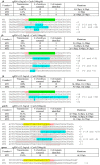Heritable and precise zebrafish genome editing using a CRISPR-Cas system
- PMID: 23874735
- PMCID: PMC3706373
- DOI: 10.1371/journal.pone.0068708
Heritable and precise zebrafish genome editing using a CRISPR-Cas system
Abstract
We have previously reported a simple and customizable CRISPR (clustered regularly interspaced short palindromic repeats) RNA-guided Cas9 nuclease (RGN) system that can be used to efficiently and robustly introduce somatic indel mutations in endogenous zebrafish genes. Here we demonstrate that RGN-induced mutations are heritable, with efficiencies of germline transmission reaching as high as 100%. In addition, we extend the power of the RGN system by showing that these nucleases can be used with single-stranded oligodeoxynucleotides (ssODNs) to create precise intended sequence modifications, including single nucleotide substitutions. Finally, we describe and validate simple strategies that improve the targeting range of RGNs from 1 in every 128 basepairs (bps) of random DNA sequence to 1 in every 8 bps. Together, these advances expand the utility of the CRISPR-Cas system in the zebrafish beyond somatic indel formation to heritable and precise genome modifications.
Conflict of interest statement
Figures





References
-
- Horvath P, Barrangou R (2010) CRISPR/Cas, the immune system of bacteria and archaea. Science 327: 167–170. - PubMed
-
- Wiedenheft B, Sternberg SH, Doudna JA (2012) RNA-guided genetic silencing systems in bacteria and archaea. Nature 482: 331–338. - PubMed
-
- Cho SW, Kim S, Kim JM, Kim JS (2013) Targeted genome engineering in human cells with the Cas9 RNA-guided endonuclease. Nat Biotechnol 31: 230–232. - PubMed
Publication types
MeSH terms
Substances
Grants and funding
LinkOut - more resources
Full Text Sources
Other Literature Sources
Molecular Biology Databases
Miscellaneous

